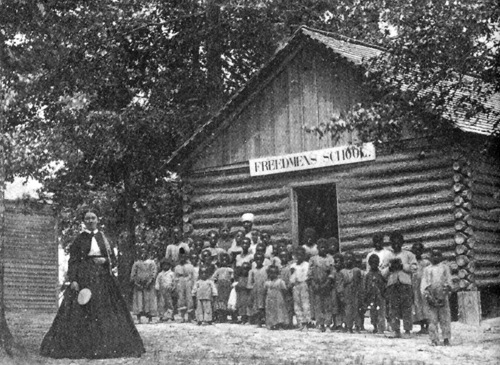** I am re-working a personal research project, and I thought I might post some thoughts about my archival findings so far. Enjoy! **
While working through some primary sources recently, I came across an article in Harper’s Weekly that featured educational institutions for Black Americans. Of particular interest to me was James’s Plantation Freedmen’s School in North Carolina.
The school was named after Reverend Horace James, a minister from Massachusetts who served as a chaplain in the Union army. In 1863, General John G. Foster, commander of the North Carolina Department of the Freedmen’s Bureau, appointed Reverend James as “Superintendent of Negro Affairs for the North Carolina District” and tasked him with maintaining the Freedmen’s Colony of Roanoke Island.
What struck me about this article in Harper’s Weekly was its description of schooling as “the true foundation of the real social reconstruction of the South.” Conceptualizing education as a means of social and cultural advancement is central to my dissertation, and I am fascinated by depictions of education in Reconstruction Era media. Furthermore, this article features “illustrations of a number of the most prominent of the schools at the South under the control and direction of the American Missionary Association of New York.” The AMA deeply influenced the development of schools for freedpeople. The organization helped educate hundreds of former slaves, but it was also a proponent of the Northern savior myth which completely ignored the contributions of Blacks in the dismantling of slavery. In fact, the article in question begins with an iteration of this myth: “When the North gave freedom to the slaves of the South it saw the necessity of giving them also the education which was necessary to their proper appreciation and employment of their liberty…The North did its duty; the schoolmaster followed the flag wherever it went…” The implication here is that newly freed slaves needed the assistance of Union soldiers and Northern schoolteachers to properly appreciate freedom, as if Black Americans had not yearned for, fought for, and died for freedom since first arriving to North America. By positioning the North as the gracious liberator to helpless, childlike hordes of African Americans, the work of Black abolitionists and educators is obscured.
“The Freedmen’s Schools,” Harper’s Weekly, October 3, 1868
In light of this idea, I’m very interested in the ways that the AMA is used to legitimize Black schools after the Civil War. Though the AMA-related institutions featured in this Harper’s Weekly article certainly did admirable work, I grow increasingly curious about less-recognized methods of education among freedpeople. African Americans were learning to read well before the AMA and the Freedmen’s Bureau were created, and they continued to educate themselves after Reconstruction ended. However, in so many newspaper and magazine articles of the day, sites of learning were not recognized unless the AMA or Freedmen’s Bureau sanctioned them. The acknowledgement of Black self-education would raise questions about Black agency, and over the course of my dissertation process, I hope to unravel the tensions around this agency as they were manifested from the Reconstruction Era through the Jim Crow Era.
Harper’s Weekly Sketch of James’s School




